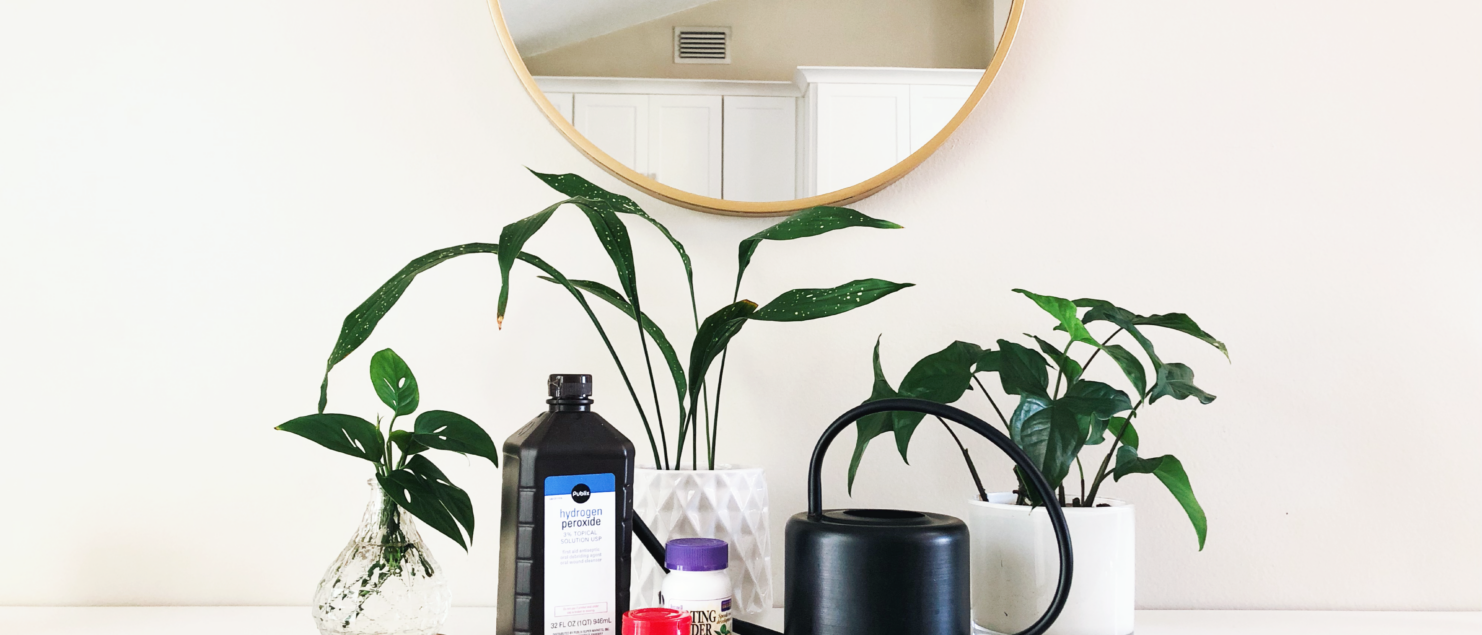How To Prevent And Treat Root Rot
What is the number one cause for a houseplant to die in my care? Root rot.
“RIP to the plants I’ve loved before”
In the past, I was known as a “serial over waterer”. I would constantly helicopter over my plants because – I loved them so much and wanted to make sure they were well hydrated, unlike myself.
Not only was I watering my plants when they didn’t need it. I also wasn’t properly mixing my soils and providing optimal drainage for my poor plants. So, basically my houseplants were ticking time bombs for root rot.

Here are some ways to prevent and treat root rot in your houseplants.
What Even Is Root Rot?
Root rot is a disease that plants can develop due to prolong exposure to extreme moisture. Essentially the roots become so waterlogged, they suffocate.
The lack oxygen is super detrimental to the plant. Once the roots become waterlogged and start to rot, the plant will not be able to absorb any more water or nutrients, basically cutting off all the supplies that the plant needs.
Ultimately causing the plant to wither away.

Your plant will often display some signs, like looking like it’s thirsty. A few of my plants that were rotting showed signs of under watering. They can look withered, dried out, and limp. Make sure you check the soil moisture before you water, because if it is rot, you could be making it worse.
The Number One Culprit
One reason and probably the most common is not having drainage holes in your planters.
This one was a biggie for me. I learned early on the beauty of a good drainage hole.
Drainage holes will prevent the water from pooling on the bottom of the planter, causing the roots to sit in water. “Plants don’t like wet feet” is a common phrase I’ve heard tossed around the plant community, and they’re right.
A lot of those pretty planters you see now a days, don’t have drainage holes. I’m not sure why, but that’s what I’ve found. But don’t lose hope on that perfect planter, you have a few options.
One option is you can find a nursery pot that fits the planter and plant the plant in that. After the plant is in the nursery planter you can pop it into the ‘cover’ pot, and viola, you now have drainage!

*Helpful trick:
If the nursery pot is a little too tall, you can cut the top off of the nursery pot.
If the planter is a little too wide at the top you can cut two slits on the side of the nursery pot on each side, which should over-lap once you put it in the cover pot (some nursery pots are more wide at the top).
When you water your plant next you can either take it out of the cover pot, water it, then let it drain out in the sink or you can leave it in the cover pot and water like normal. After a few minutes, simply take the plant and nursery pot out and pour out any excess water from the cover pot.
Another Big Culprit
The next culprit leading to root rot is poorly draining soil/not correct soil for plant. When I used to pot a plant, I would reach for my commercial brand potting soil mix, plant the plant and done.
Now, that’s not always the wrong way, but I have a better way to amp up your soils for each plant.

Just by simply researching your plant types soil requirement is a big step in the right direction. Often times you’ll want to add things like charcoal, perlite, coco coir, bark, or moss. These things can help lighten and fluff up your soils for a fool proof *ahem, I mean rot proof (in a way) soil.
All kidding aside, these additives will help to aerate the soil, which can help the plant get the oxygen it needs and be able to dry out a little faster.
It All Comes Down To One
And the biggest and well, a no brainer for the top culprits for rotting your plants is: over watering.
Ok duh, right?! But it’s true. Don’t be like I used to and over water because you heard that the plant needs water every week. Make sure you check the plants soil before watering.

Not having a drainage hole or good draining soil will help contribute to over watering, as well. If you have good drainage all around, and over water here and there it will be more forgiving.
Moisture meters have been such a lifesaver in my home jungle, and probably has saved quite a few plants. You can also just use your finger, by putting your finger 2 inches into the soil and seeing if it still has moisture to it or not. If the plant doesn’t seem to need water – check again in a few days.
Steps To Treat Root Rot
So, you’ve spotted your plant looking strange, you’ve un-potted it and it has a mildewy-earthy smell to it.
Are the roots brown/black and mushy/slimy to the touch?
If you said yes…

Well, my friend. You have root rot.
Here are some of the steps on how I treat and prevent root rot, and how I’ve saved my houseplants.
- Once you’ve identified the root rot, you need to assess how bad the plant is. Any sign of white-yellow roots, you have some chances to save some of the root system. If it’s all brown/black/reddish, then you may need to start over and propagate what you can.
If your plant needs to be propagated: Check out my propagation blog here
- Discard any soil the plant was in and disinfect your pot. I spray my pots down with diluted bleach, and rinse WELL with hot water.
- Rinse any soil or debris from the roots with cool water. By doing this, you’ll be able to see what can be saved.
- If you have roots that are salvageable: While using sterilized scissors, cut off any rot and leave the ‘good’ roots attached. You should also cut off any foliage that is damaged, as well.
- Mix a solution of 3 parts hydrogen peroxide and 7 parts filtered room temperature water and place the roots in the solution for around 10 minutes. You’ll start to see fizzing and bubbling, this is a big indication you have root rot and the hydrogen peroxide is hard at work, killing it.
- Rinse off the hydrogen solution from your plant.
- Place your plant in some water to plump up the leaves, and help promote more root growth, or you can plant the plant directly into soil, if the foliage looks ok.
- (optional) When your plant is ready to be planted, roll the roots in cinnamon and rooting hormone. The cinnamon is a natural fungicide, so this can help prevent diseases coming back to your plant. The rooting hormone helps to promote the roots to grow a bit quicker, to help support the plant.
- Plant your plant back in fresh sterile soil, and water sparingly for a few weeks. Make sure you keep your plant out of sunlight for a few weeks, or until the foliage is back to normal.
It Happens To The Best Of Us
Don’t think that if root rot happens to you, you’re a bad plant parent. It happens to everyone at some point. Even the most experienced houseplant gurus can get rot from time to time.
Make sure you just keep in mind that there are many ways to help prevent and treat root rot in your houseplants. And make sure you water your plants when they need it, and keep an eye on its behavior. You probably will know right away when something is up.
Good luck out there planty friends!
Hope this guide will help you prevent and treat root rot in your houseplants, and/or potentially save some of your leafy friends.
Check out my socials!
Instagram – @Botanicalbrunette_


